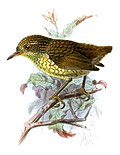| White-bearded flycatcher | |
|---|---|
 | |
| Scientific classification | |
| Kingdom: | Animalia |
| Phylum: | Chordata |
| Class: | Aves |
| Order: | Passeriformes |
| Family: | Tyrannidae |
| Genus: | Phelpsia Lanyon, 1984 |
| Species: | P. inornata |
| Binomial name | |
| Phelpsia inornata (Lawrence, 1869) | |
 | |
| Synonyms | |
| |
The white-bearded flycatcher (Phelpsia inornata) is a species of bird in the family Tyrannidae, the tyrant flycatchers. [2] It is found in Colombia and Venezuela. [3]


